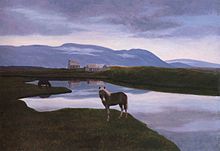Icelandic art
The art of Iceland developed from Northern European traditions of the 19th century, but developed in different directions in the 20th century, influenced in particular by mythology, culture and the characteristic Icelandic landscape.
Origins
The origins of contemporary Icelandic art are often traced to the work of Þórarinn Þorláksson who, after receiving a formal art education in the 1890s in Copenhagen, returned to Iceland to paint and exhibit from 1900 until his death in 1924, which largely dealt with the landscape of the island.
Also trained in Denmark was Ásgrímur Jónsson, who with Þorláksson created distinctive depictions of their country's landscape in a romantic and naturalistic style.
Landscape painting
The particularities of the representation of the Icelandic landscape by its painters can be linked to nationalism and the independence movement, very active during this period. Other landscape painters soon followed in the footsteps of Þorláksson and Jónsson, such as Jóhannes Kjarval, Jón Stefánsson and Júlíana Sveinsdóttir. Kjarval was characterized by his pictorial technique to represent the volcanic rock that dominates the Icelandic environment.
The Rise of Abstract Art
Abstract art rose to prominence in the mid-20th century, spearheaded by artists such as Svavar Guðnason and Nína Tryggvadóttir. Other artists, such as Gunnlaugur Scheving, eschewed abstraction in favor of a narrative content and an understanding of color and form influenced by Fauvism and Cubism. Louisa Matthíasdóttir, based in New York, was characterized by the use of abstract expressionism.
The return of figurative art
Einar Hákonarson's 1968 exhibition marked a distance from the island's dominant art scene as his works were pop, figurative and expressionist. This show brought figuration back to Icelandic painting, Hakonarson said he was inspired more by his feelings towards nature than by a specific part of it.
Icelandic art of the late 20th century
Landscape remains a predominant theme in Icelandic art today, which is reflected in the National Gallery's exhibitions. The art community has held debates about whether an appropriate balance has been struck in terms of support for galleries by media, traditions and personalities in Icelandic visual art.
Contenido relacionado
Apache (film)
Guitar
Antoni Gaudí
